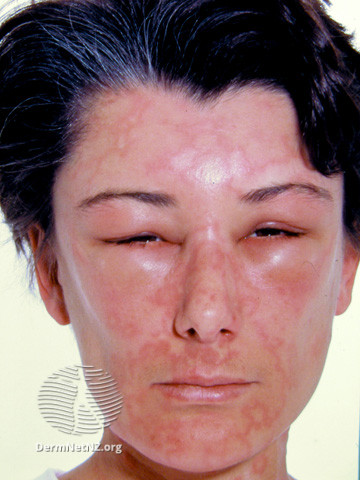
Angioedema
Subcutaneous swelling with or without rash. Urticaria and angioedema images (hives) | DermNet (dermnetnz.org)

Acute Urticaria
- Patients present with sudden onset of very itchy, transient wheals (raised pink and white itchy lesions like nettle rash) which resolve in under 24 hours and can recur for up to 6 weeks. May be accompanied by angioedema.
Chronic Urticaria
Regular episodes persisting for more than 6 weeks, fluctuating in intensity. There may be associated dermographism (wheals that appear when skin is firmly rubbed or stroked). Spontaneous resolution can take months or years, though the average time to resolve is between 6 to 12 months.
R.C 18-05-23
Criteria for referral
Persistent urticaria / angioedema unresponsive to 3 different anti-antihistamines each for 4–6 weeks, despite using 4 times the licensed dose as below.
Urticarial vasculitis with associated joint pains, fever, abdominal pain, diarrhoea, and or persistent wheals (for more than 24 hours) and bruising.
Do not refer for allergy testing unless patient has had episode of definite anaphylaxis.
Do not refer for patch testing as it is of no value in this context.
Causes of acute urticaria:
It is very important to take a detailed history, as this is more likely to give you the cause of acute urticaria than any investigations.
In most cases of urticaria, no underlying cause is found.
Laboratory tests (IgE) are rarely necessary and done only to confirm suspected specific triggers. The more common allergies causing acute urticaria include:
Drugs
- Antibiotics such as penicillin
- Aspirin and other NSAID
- ACEI can cause both urticaria and also angioedema without urticaria
- Many other drugs have been implicated
Food
- The majority of food allergies causing urticaria are caused by nuts (especially peanuts and tree nuts), white fish (eg cod), shellfish (e.g. prawns), hen eggs, milk and some fruits (especially strawberries, kiwis and citrus fruits), though many other foods can be responsible.
Bee and wasp stings
Idiopathic
Infection
Picornavirus (most common), coronavirus, respiratory syncytial virus, and several others including the hepatitis viruses and HIV. Mycoplasma infections in children may also cause acute urticaria.
Rarely – exercise (with or without associated food allergy as a co-existent trigger)
Treatment of acute urticaria:
- Non-sedating antihistamines as per formulary. If standard dose is ineffective titrate up to 4 fold the dose over one to two weeks
- Sedating antihistamines: additionally at night if sleep disturbed e.g. 10-30mg hydroxyzine nocte
- Continue regular treatment until symptoms subside
Causes of chronic urticaria:
- Idiopathic – most cases
- Physical urticarias – Urticaria may be triggered by heat, cold, friction, pressure on the skin and even by water. The wheals usually occur within minutes, and last for less than one hour (except delayed pressure urticaria). Physical urticarias usually occur in healthy young adults, and are not uncommon. Some patients suffer from more than one type of urticaria; they include the following types:
- Dermographism
- Cold urticaria.
- Solar urticaria.
- Aquagenic urticaria.
- Delayed pressure urticaria.
- Cholinergic urticaria
- Contact urticaria
Auto-immune aetiology
Treatment of chronic urticaria:
- Non-sedating antihistamines daily for 6 months If standard dose is ineffective titrate up to 4 fold the dose over one to two weeks
- Sedating antihistamines: additionally at night if sleep disturbed e.g. 10-30mg hydroxyzine nocte
- Topical anti-pruritic: 0.5-5% menthol in aqueous cream or crotamiton 10% cream (Eurax).
Causes of angioedema:
- ACE inhibitors
- Idiopathic
- C1 esterase inhibitor deficiency is rare and specific treatment is required
Investigation of angioedema without urticaria:
- Check complement C4 levels
- Take detailed Family History (sudden/ unexplained death)
Stop any histamine releasing drugs if able, e.g. aspirin, codeine, ACE inhibitors, penicillin, non-steroidal anti-inflammatory drugs and if possible treat potential sources of infection.
Therapeutic Tips
- Advise patient to avoid suspected triggers: stress, heat, tight clothing, alcohol, caffeine.
- Change to alternative anti-histamine after 4–6 weeks if one agent has not helped and tritrate up the dose as needed to 4 fold. Try up to 3 different antihistamines.
- If non sedating antihistamines are not effective a short 4-5 day course of prednisolone may be warranted in severe acute urticaria or in exceptional circumstances( job interview/getting married) in chronic urticaria.
- Do not prescribe H2 blockers or topical steroids or longterm corticosteroids.
For Patients
- BAD patient information sheet: https://www.bad.org.uk/library-media/documents/Urticaria and Angioedema Update Sept2012-lay reviewed May2012.pdf?













